BERKELEY, CA (UroToday.com) - This supplemental commentary endeavors to place Dr. Flocks’ work in the context of our present knowledge and treatment dimensions. Additionally, we would like to illustrate some of the sophisticated basic science study published and pioneered by Titus Carr Evans Sr., PhD that supported the clinical observations by Dr. Flocks (urology), Dr. H. Dabney Kerr (radiology), and Dr. Higdon Elkins (radiation oncology).
Dr. Evans1, 2 measured the amount of gold colloid circulating in the patient’s venous blood shortly (1-26 minutes) after injection.
He was also able to demonstrate uptake in the liver 1 and 5 days postoperatively. In selected patients, radio autographs of the pelvic lymph nodes demonstrated the potential value of treating regional lymph spread of prostate cancer in these patients.
All of these basic imaging studies demonstrated the pathophysiology of colloidal gold therapy over surgery alone.
Today, in the PSA era, surgical removal of prostate cancer has been associated with reduction in cancer deaths in the literature. Why some prostate cancer patients with advanced disease are long-term survivors is not known. Historic retrospective review of pathological specimens (from patients surviving over 15 years) may allow the present urological community to develop patient pathology criteria for predicting successfully treated cancer.
Currently, to determine who is most likely to have curative surgery, certain criteria are used such as Gleason score, negative surgical margins, absence of seminal vesicle extension, and absence of bladder neck and membranous urethral involvement. The volume of prostate cancer itself, however, may also indicate who would be a safe and appropriate candidate for surgical removal.
As urologists assess patients for active surveillance, what is the tumor burden that can be observed expectantly? What are the cancer burdens that bode impending failure? Dr. William. J. Catalona, Professor in Urology at Northwestern University Feinberg School of Medicine, has suggested that we scrutinize our data not only looking for success but also for when surgeons fail to eradicate disease. When do we know “watchful waiting” represents an inappropriate risk for the patient? In our view the pathology staging of these long-time survivors may provide guidance about surgical “curability.”
Flocks’ long-term survivors (15-35 years) and those in other series like the Mayo Clinic and Johns Hopkins could provide a pathology database to help answer these questions since their patients' data represent long-term proven success.
Dr. Flocks knew the limitations of his pre-operative assessment trying to avoid failure manifested in local recurrence, regional lymph node involvement, and distant dissemination to bone, liver, and lung. The retrospective analysis of these data combined with a modern histological re-analysis may allow us to more accurately stage our present PSA-positive patients moving toward the “ideal” surgical or irradiation cohort.
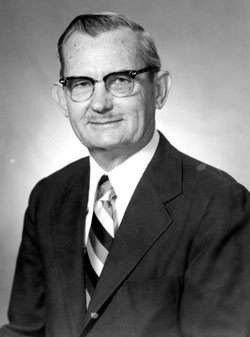
FIGURE 1. Professor Titus C. Evan Sr., PhD
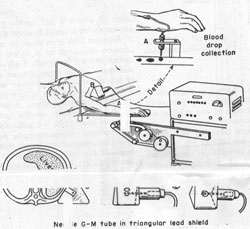
FIGURE 2. The blood drop device
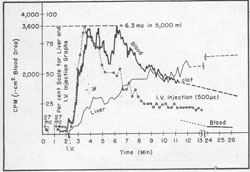
FIGURE 3. The radioactivity readings gleaned
immediately after injection
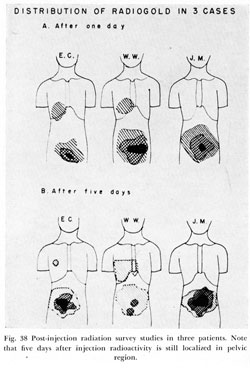
FIGURE 4. AU198 at 1 and 5 days PO3
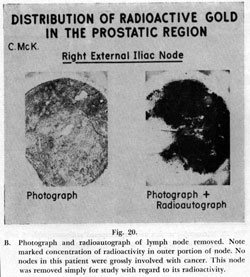
FIGURE 5. AU198 uptake in pelvic node4
References:
- Flocks, R.H., and Evans, T. C. Sr. "Therapeutic Use of Artificial Radioisotopes," Chapter 12, The Treatment of Carcinoma of the Prostate with radioactive Gold, John Wiley and Sons, pages 266-7.
- Rounds, W. M., and Evans, T.C. Sr., Blood Drop Determination of AU198 in Prostate Therapy, Nucleonics 52-4, 1955
- Flocks, R.H., and Culp, D.A., "Radiation Therapy of early Prostatic Cancer," Chas. Thomas, Springfield IL 1960. Page 68.
- Ibid, page 41.
Written by:
Charles E. Hawtrey, MD and Michael O'Donnell, MD as part of Beyond the Abstract on UroToday.com. This initiative offers a method of publishing for the professional urology community. Authors are given an opportunity to expand on the circumstances, limitations etc... of their research by referencing the published abstract.
Rubin H. Flocks and colloidal gold treatments for prostate cancer - Abstract



